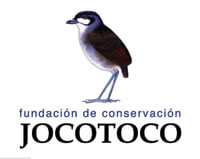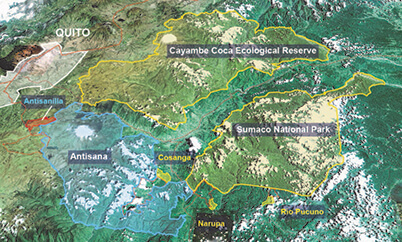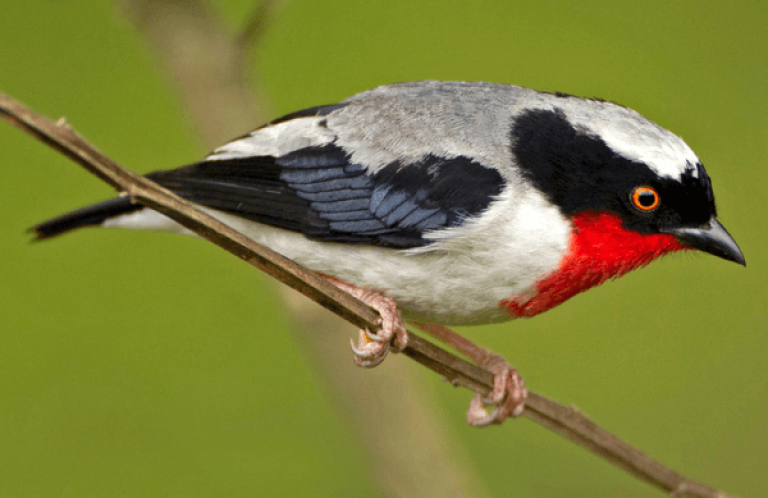Key Population of Andean Condors Protected by Land Purchase in Ecuador
 |
 |
(Washington, D.C., January 24, 2014) About half of Ecuador's rare Andean Condors, among the world's largest flying birds, will be better protected through a just-completed, 7,000-acre conservation land purchase in Ecuador totaling $1.6 million and adding to the 1.8 million acres of protected habitat in the Antisana region—an area larger than the state of Delaware.
The newly acquired property, called Hacienda Antisanilla, is located on the western slopes of the magnificent Antisana Volcano in central Ecuador. It sits at the edge of the Greater Antisana area in one of the largest wilderness areas in Ecuador, located only about 30 miles southeast of the capital city of Quito. The purchased land will become part of the buffer area surrounding the Antisana Ecological Reserve, a spectacular 350,000-acre area of high-altitude forests and páramo grasslands.
“The condor is an extremely important bird for Ecuador, much like the Bald Eagle is for the United States,” said Rocío Merino, Executive Director of Fundación Jocotoco, the organization that manages the reserve. “It is a symbol of the country and is even on the national coat-of-arms. Without question, it captures the imagination of Ecuadorians unlike any other animal. Protecting it was a major motivating force behind so many people coming together to make this happen.”
“The purchase and ownership of Antisanilla completes the protection of one more key piece in the region's conservation mosaic,” said George Fenwick, President of American Bird Conservancy, one of the key supporters of the acquisition. “It will serve to safeguard Ecuador's most important population of Andean Condors and will significantly aid efforts to continue growing a thriving and self-sustaining ecotourism program in the country.”
The land purchase became a priority following the remarkable discovery that the most significant population of Andean Condors north of southern Peru and Bolivia was on Hacienda Antisanilla. Up to 40 condors nest and roost on the cliffs at Antisanilla, representing over 50 percent of the condor population in all of Ecuador. This discovery quickly became a high-profile issue that was remarkably coincidental with Hacienda Antisanilla being for sale. The partners jumped at the opportunity to protect the land in perpetuity.
“The leadership within Ecuador has been tremendous including the Centro de Rescate Ilitio and Grupo Nacional de Trabajo del Condor Andino, which has supported this project with vital resources to benefit the entire country,” said Francisco Sornoza, Conservation Director of Fundación Jocotoco.
The purchase is important for several reasons in addition to protecting the condor. The region protects a vital source of water for the residents of Quito. The site's proximity to the capital has resulted in it becoming a rapidly developing area, putting significant pressure on natural areas and resources. Those development forces clash with the preservation of tropical Andean cloud forests and grasslands such as those found in the Antisana region, which contain remarkable species richness, high levels of endemism, and multitudes of rare and endangered species.
Although not as rich in diversity as the Amazon Basin, these lands are inhabited by numerous rare and endemic species of fauna and flora and are extremely fragile because plants grow so slowly in the tropical alpine climate.
 |
Grazing and fire pose threats to the páramo ecosystem at higher elevations, and the new reserve will act to limit these impacts. For instance, cattle will be gradually removed from sensitive areas and replaced with south American camelids such as llamas and alpacas through a reintroduction program. In this way, permanent food availability for Andean Condors will be ensured while the grassland ecosystem is restored.
“Fortunately, the protection of this new property will buffer the Antisana Reserve and help control access to the land. Gradually, this will reverse the process of ecosystem degradation caused by fire. It will also help limit illegal hunting that has impacted populations of important wildlife,” said Benjamin Skolnik, American Bird Conservancy's Ecuador Director.
Those species include major predators such as puma, Andean wolf, mountain tapir, and spectacled bear. In addition to hosting the Andean Condor, these páramo areas are also important to Silvery Grebe and Andean Ibis, now considered a separate species from the more-common Black-faced Ibis. The lakes, marshes, and bogs provide important habitat for both resident and migratory shorebirds, as well as many special waterfowl.
“This integrated conservation area incorporates one of the largest elevation gradients in the world, stretching from 3,900 to 18,875 feet above sea level. This range of elevations within protected areas is critically important in a time of climate change,” said ABC's Fenwick.
Antisana bridges two adjacent protected areas, both of them also very large: Cayambe Coca Ecological Reserve to the north and Sumaco National Park to the east. Together with Antisana, this conservation mosaic safeguards an area larger than the state of Delaware—an extraordinary 1.8 million acres of critically important and diverse Andean and Amazonian habitat.
“The acquisition of Hacienda Antisanilla helps protect not only the specific biodiversity values of the area, it also provides a critical strengthening and safeguarding of the connections and corridors to other protected areas,” said Jocotoco's Merino.
 |
The Antisanilla property also presents a remarkable tourism and economic opportunity. Over the past 10 years, Jocotoco has developed a birdwatching and ecotourism program that now hosts 10,000 visitors each year to its reserves, with over 70 percent of the visitors being Ecuadorian. The program directly or indirectly employs more than 40 people in rural areas, and income from tourism covers nearly 20 percent of the foundation's operating budget.
Proximity to Quito will allow weekend visitors to experience the exceptional beauty of the high-elevation grasslands and to witness the inspiring flight of the condor. The neighboring Guaytara property operates a restaurant and hotel from which guests can easily access the new Antisanilla Reserve.
The acquisition coincides with the first successful release of an Andean Condor in Ecuador with a satellite transmitter. After rescue and rehabilitation, “Felipe,” a young condor, was released with fanfare and tracked remotely by biologists from The Peregrine Fund, Centro de Rescate Ilitio, Universidad San Francisco, and Jocotoco.
“Demonstrating the amazing range of these birds, in just the first week, the condor traveled more than 93 miles and soared over volcanoes in three different provinces,” said Hernan Vargas, The Peregrine Fund's research biologist based in Ecuador. This project has catalyzed interest in convening an effort to implement a species action plan for the Andean Condor in Ecuador to address its decline. The plan will be implemented by the National Andean Condor Work Group, which includes Jocotoco among its members.
Antisana is one of the Alliance for Zero Extinction (AZE) sites of Ecuador, due to the presence of three species of threatened frogs in the genus Pristimantis.
The private and governmental groups who worked to assist Jocotoco in its effort to protect this crucial area for conservation include:
| In Ecuador: | Centro de Rescate Ilitio Grupo Nacional de Trabajo del Condor Andino (GNTCA) Estudio Jurídico Gallegos y Asociados The Peregrine Fund – EcuadorCabañas San Isidro EcoFondo Empresa Municipal de Alcantarillado Agua Potable (EMAAP) Estación Científica Yanayacu Familia Vallejo, Hacienda Guáytara Ministerio del Ambiente, Government of Ecuador Ministerio del Turismo, Government of Ecuador Municipio de Quito Museo Ecuatoriano de Ciencias Naturales Parque Zoólogico de Guayllabamba |
| International: | Paul G. Allen Foundation American Bird Conservancy blue moon fund Butler Foundation Global Wildlife Conservation The March Foundation The Peregrine Fund – USRainforest Trust Andrew Sabin Family Foundation The Robert W. Wilson Charitable Trust World Land Trust |


















































